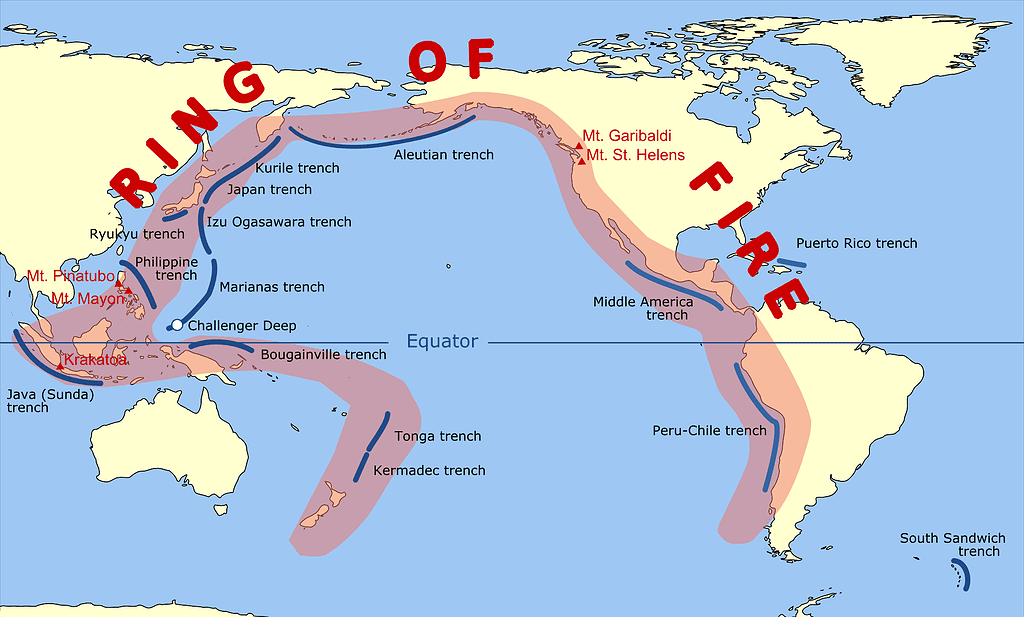
You may have heard of the Ring of Fire, but what exactly is it? I’m not referring to the popular drinking game or even a literal ring of flames, but rather something much more interesting and geological in nature.
What is the Ring of Fire?
The Ring of Fire is a horseshoe-shaped area in the Pacific Ocean that is home to some of the most active and dangerous volcanoes on Earth.
In fact, 90% of all earthquakes and 75% of the world’s volcanic activity occurs in this region, which forms a loop that begins in New Zealand, extends across the Philipines, Japan, the Bering Strait, Alaska, the coasts of North, Central, and South America, before ending at the southern tip of the South American continent.
The Ring of Fire is truly a geological marvel that quite literally shapes our world. But how did the Ring of Fire come to be?
How the Ring of Fire Formed
The Ring of Fire is a product of plate tectonics, the movement of massive slabs of rock that make up the Earth’s crust and float on the molten rock below. These tectonic plates are not static but rather are in constant motion, moving by up to 10 centimeters (4 inches) per year.
The boundaries between these plates are where most of the Earth’s geological activity occurs, explaining volcanic eruptions and earthquakes, as well as the formation of many islands.
The Pacific Plate is the largest tectonic plate on Earth, and it is constantly moving northwest, colliding with the smaller neighboring Philippine, Juan de Fuca, Cocos, Antarctica, and Nazca plates.
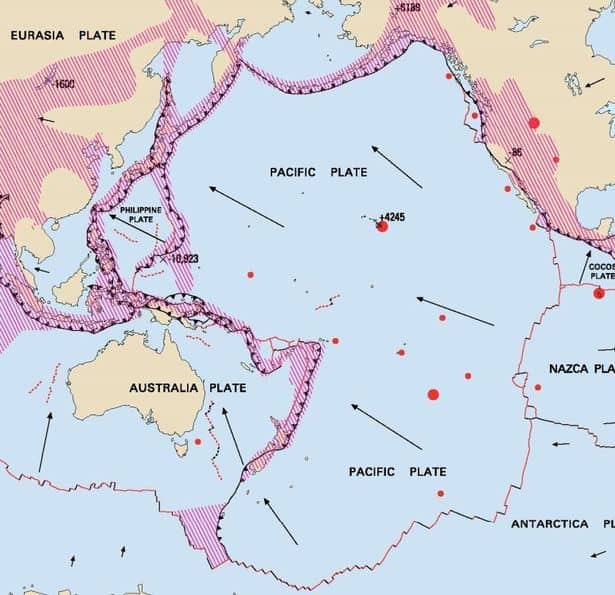
As these plates collide, the resulting intense heat and pressure cause the Earth’s crust to buckle, crack, and break. This process creates fissures in the Earth’s crust, allowing magma, gas, and other materials from the underlying mantle to escape.
As a result, the Ring of Fire is home to over 400 active volcanoes, more than 450 dormant ones, and thousands of sizable earthquakes every year.
There are several different types of tectonic plate boundaries, but the ones that are most relevant to the Ring of Fire are convergent, divergent, and transform boundaries.

Convergent boundaries
Convergent boundaries occur when two plates collide, and the heavier plate is forced beneath the lighter one. This process is called subduction, and it results in the formation of deep trenches, through which buoyant magma rises through the crust to the surface, eventually forming new volcanoes.
The volcanic activity around the boundaries of the Pacific plate traces an arc dotted by islands and continental mountain ranges, which run parallel to corresponding deep ocean trenches along the Ring of Fire. For instance, the Andes Mountains run parallel to the Peru-Chile Trench and Alaska’s Aleutian Islands run parallel to the Aleutian Trench.
Divergent boundaries
Divergent plate tectonic boundaries operate in reverse to convergent boundaries. They are formed by tectonic plates that pull apart from each other, explaining seafloor spreading and rift valleys.
Hot magma seeps through these rifts but is quickly cooled by the cold seawater, creating new crust. Over millions of years, this process has consolidated high ridges on the ocean floor.
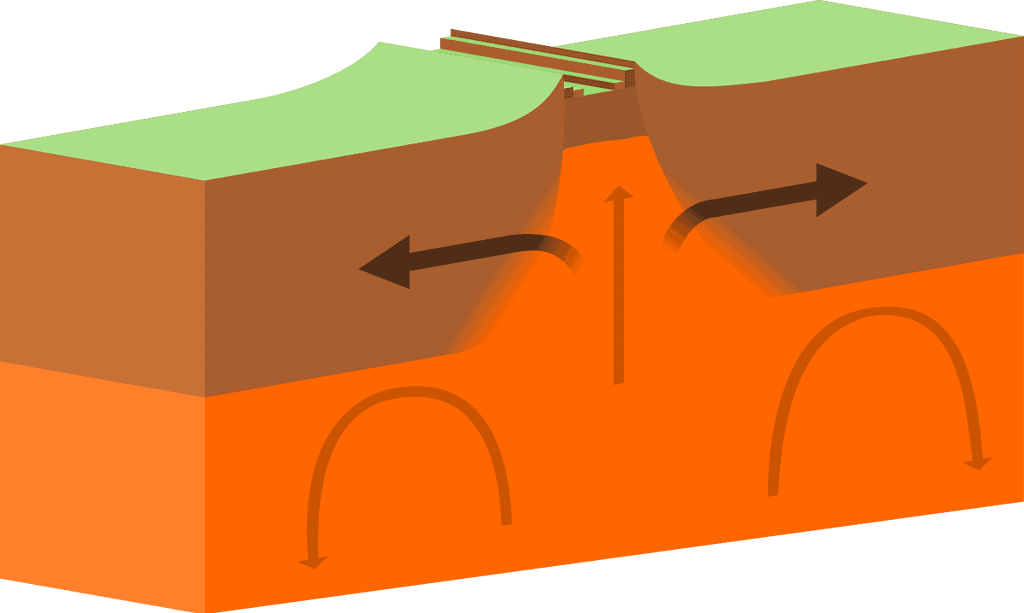
One of the most important geological features of the Ring of Fire formed by a divergent boundary is the East Pacific Rise. The rise is located on the divergent boundary of the Pacific Plate and the Cocos Plate (west of Central America), the Nazca Plate (west of South America), and the Antarctic Plate.
Transform boundaries
Transform boundaries occur when two plates slide past each other horizontally, and they’re responsible for the majority of the earthquakes that occur in the Ring of Fire.
As the plates grind against each other, they create friction that can build up for years before the energy is suddenly released in a sudden and violent jolt. This is why we have earthquakes, but also faults like the San Andreas fault around the areas where rock at the tectonic plate boundaries breaks or slips.
These geological forces have been active for billions of years, and as a result, the Ring of Fire has been shaped by many different types of volcanoes and hot spots.
There are stratovolcanoes, which are tall and conical and have explosive eruptions, shield volcanoes, which are broad and gently sloping and have more effusive eruptions, and calderas, which are collapsed volcanic craters.
For much of its 40,000-kilometer (25,000 miles) length, the Ring of Fire, also known as the Circum-Pacific Belt or Pacific Ring of Fire, follows the island arcs such as Tonga and New Hebrides, the Indonesian archipelago, the Philippines, Japan, the Kuril Islands, and the Aleutians, as well as other arc-shaped geomorphic features, such as the western coast of North America and the Andes Mountains.
Ring of Fire Eruptions in History
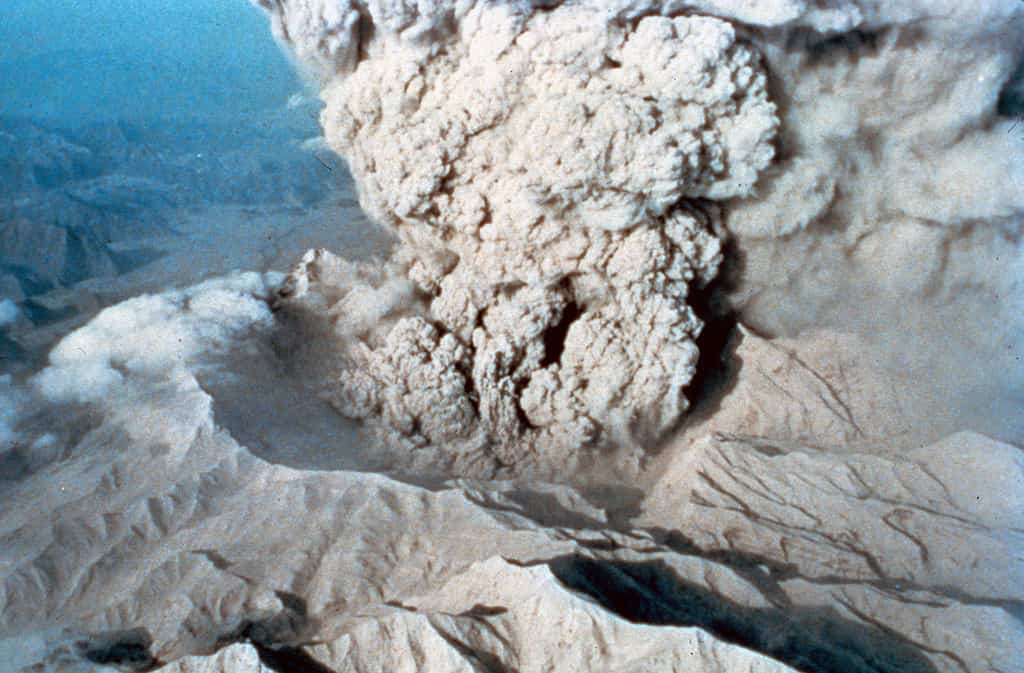
Living inside the Ring of Fire can sometimes be incredibly dangerous. Volcanoes can erupt with little warning, sending ash and debris high into the air and creating massive mudflows that can bury entire towns. Earthquakes can strike suddenly, toppling buildings and bridges and triggering deadly tsunamis that can devastate coastal communities.
The Ring of Fire has a long and storied history of volcanic eruptions, some of which have been catastrophic. In 1815, the eruption of Mount Tambora in Indonesia was perhaps the most powerful explosion on Earth in the past 10,000 years. The blast directly killed thousands of people and caused a volcanic winter and an entire year without a summer in much of the Northern Hemisphere due to 12 cubic miles of gas, dust, and rock that were ejected into the atmosphere, where the particles blocked sunlight.
In 1883, the eruption of Krakatoa, also in Indonesia, was so loud it could be heard over 3,000 miles away, and it caused a tsunami that killed tens of thousands of people. Scientists believe that, to this day, Krakatoa’s eruption marks the loudest sound in history.
In more recent times, the eruption of Mount Pinatubo in the Philippines in 1991 was one of the largest of the 20th century, triggering a magnitude 7.8 earthquake and spewing ash and gas high into the atmosphere and causing global temperatures to drop by about 0.5 degrees Celsius between 1991 and 1993.
The 2004 Indian Ocean tsunami was one of the worst natural disasters in recent history, killing over 200,000 people. It was triggered by a very powerful undersea earthquake off the coast of Sumatra island in Indonesia on December 26, 2004, which is why the event is sometimes called the Christmas or Boxing Day Tsunami.
And most recently, in January 2022, the Hunga Tonga-Hunga Ha’apai volcano eruption served as a wake-up call reminding us that we still know very little about the Ring of Fire and its many hidden perils. The little-known seamount along a chain of 20 similar volcanoes that make up the Tongan part of the Pacific “Ring of Fire” has firmly established itself as the most powerful natural explosion in a century.
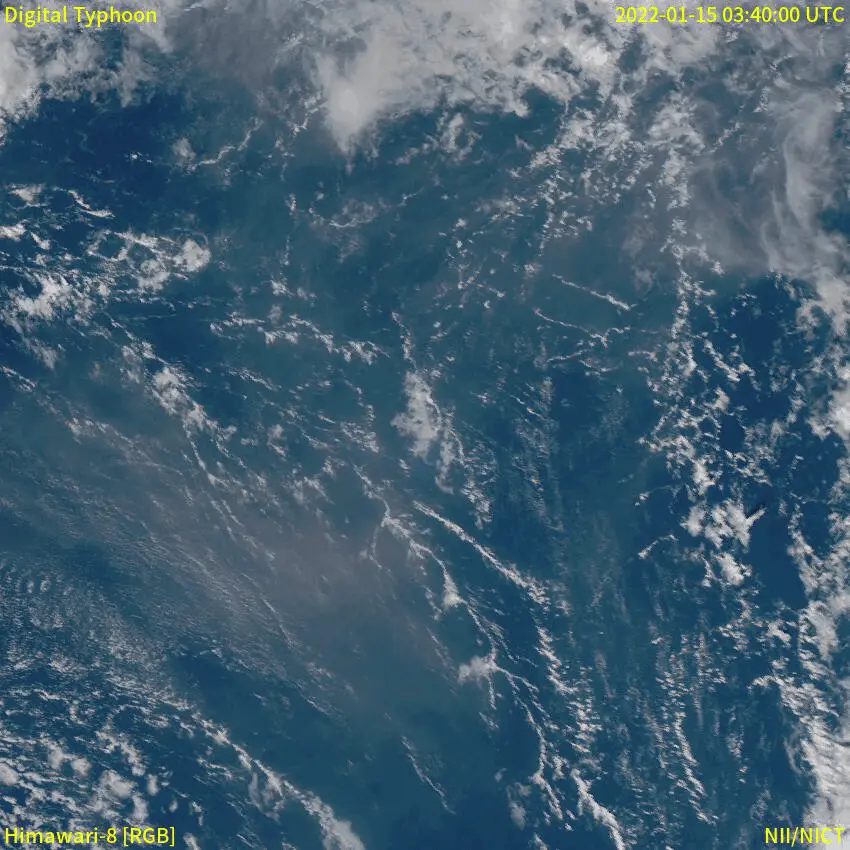
The underwater Tonga volcano eruption unleashed a force greater than the explosion of the largest U.S. nuclear weapon at 15 megatons of TNT. The eruption also generated a staggering 45-meter (148 feet) high tsunami along the coast of the Kingdom of Tonga’s Tofua Island and waves up to 17 meters (56 feet) on Tongatapu, the country’s most populated island.
“We realized immediately that the event which had just occurred in Tonga was of such a large magnitude that it was unique in the modern era,” Sam Purkis, a marine geoscientist at the University of Miami Rosenstiel School of Marine, Atmospheric, and Earth Science, told ZME Science.
Yet, despite its frightening intensity, only a small number of casualties were recorded as of result of the 2022 Tonga tsunami, thanks to excellent preparedness efforts leading up to the event and the fortunate isolated location of the epicenter. However, there are many other undersea volcanoes in the Ring of Fire, and next time we might not be this lucky.
“Obscured from casual view, submarine volcanoes are much harder to monitor than volcanoes on land. Our study provides a guide as to the behavior of submarine volcanos in the run-up to a tsunami-generating explosion. We show how a series of small blasts hailed the arrival of the “big one” which generated the largest tsunami,” Purkis said.
Geography of the Ring of Fire
The Ring of Fire encompasses the edges of the Pacific Ocean and is commonly referred to as the Pacific Rim. This region stretches from the west coast of South America to Alaska, and then south to New Zealand, Papua New Guinea, and beyond.
The region includes more than 450 volcanoes, many of which are still active today, which is over 75% of the world’s total.
Some of the most well-known volcanoes in the Ring of Fire include Mount St. Helens in the United States, Mount Fuji in Japan, and Mount Vesuvius in Italy.
Beyond volcanoes, the Pacific Rim is also home to several mountain ranges and island chains, which were formed by the movement and collision of tectonic plates. The Andes Mountains in South America, the Cascade Range in North America, and the Japanese Islands are all part of the Pacific Rim.
And because of the frequent subduction, the Ring of Fire is rich with several subduction zones, including the Peru-Chile Trench, the Aleutian Trench, and last but not least the Mariana Trench. The Mariana Trench, which is located in the western Pacific Ocean, is the deepest part of the ocean and reaches a depth of over 36,000 feet (11,000 meters).
The Ring of Fire: a Massive Natural Science Experiment
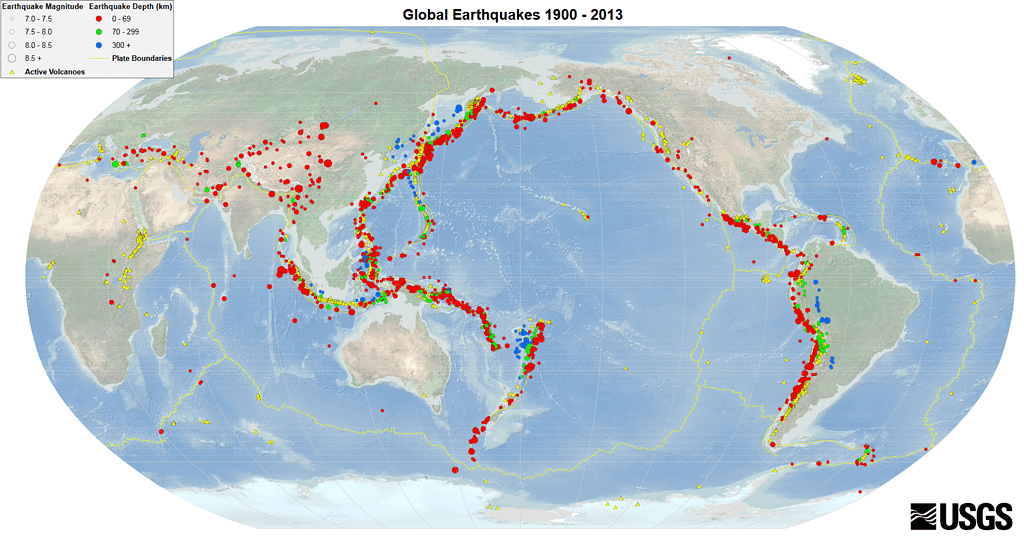
Despite the dangers of the Ring of Fire, it’s also an incredibly important region for scientific research. By studying the earthquakes, volcanoes, and other geologic phenomena that occur here, scientists can gain a better understanding of how the Earth works and how we can better prepare for future disasters.
One important tool for studying the Ring of Fire is seismology. Seismologists use sensors called seismometers to detect and measure the vibrations caused by earthquakes. By studying these seismic waves, scientists can learn more about the structure of the Earth’s interior and the forces that drive tectonic activity.
Volcanologists also play an important role in studying the Ring of Fire. They monitor active volcanoes, using a variety of tools to measure things like temperature, gas emissions, and seismic activity. By studying these factors, they can make predictions about when a volcano might erupt and how severe the eruption might be.
The Ring of Fire also has a significant impact on the environment and global climate. Volcanic eruptions can release large amounts of ash and gases into the atmosphere, which can have a cooling effect on the Earth’s climate. However, they can also release harmful gases, such as sulfur dioxide, which can cause acid rain and impact air quality.
Finally, geologists study the rocks and landforms of the Ring of Fire to gain a better understanding of the history of the region. By examining the layers of rock and sediment that make up the Earth’s crust, they can learn about the past movements of the tectonic plates and the volcanic activity that has shaped the landscape.
Interesting Facts about the Ring of Fire
- The Ring of Fire is home to some of the world’s most active volcanoes, including Kilauea in Hawaii, which had been erupting continuously since 1983 until 2017.
- The Ring of Fire is also home to the deepest place on Earth, the Mariana Trench, which is over 36,000 feet deep.
- The Pacific Plate is the only tectonic plate that is entirely covered by water.
- The Pacific Rim is home to over 450 active and dormant volcanoes, which is over 75% of the world’s total.
- The 1883 eruption of Krakatoa in Indonesia, one of the most famous eruptions in the Ring of Fire, was estimated to be four times more powerful than the most powerful nuclear bomb ever detonated.
- Volcanic eruptions in the Ring of Fire can release large amounts of ash and gases into the atmosphere, which can have a cooling effect on the Earth’s climate.
- The Ring of Fire is constantly changing and evolving. New volcanoes and islands are being formed, while others are becoming dormant or extinct.
- The Cascadia Subduction Zone, located offshore from northern California to southern British Columbia, is overdue for a major earthquake, and scientists are closely monitoring the area to prepare for a potential disaster.
- The Ring of Fire has played a significant role in shaping the geography and ecosystems of the surrounding areas. Volcanic ash and lava can create new land, and the nutrients released by volcanic eruptions can create fertile soil that supports diverse plant and animal life.
- In addition to volcanic eruptions and earthquakes, the Ring of Fire is also prone to other natural disasters such as tsunamis, landslides, and typhoons. These events can cause significant damage and loss of life, particularly in densely populated areas.
Despite the dangers posed by the Ring of Fire, it’s a testament to the power and beauty of our planet. The geological processes that created this horseshoe-shaped region continue to shape our world today, and the volcanoes that dot the landscape are a reminder of just how small we are in the grand scheme of things.
Whether you’re a scientist studying plate tectonics or a tourist taking in the sights, the Ring of Fire is a fascinating and awe-inspiring place that deserves our attention and respect. We’d be wise to study it and be prepared for whatever may come.
FAQ
The Ring of Fire is a horseshoe-shaped region around the Pacific Ocean known for its frequent volcanic eruptions and earthquakes.
The Ring of Fire formed as a result of tectonic activity along the edges of the Pacific Plate.
Some notable eruptions include the 1883 eruption of Krakatoa in Indonesia, the 1980 eruption of Mount St. Helens in the United States, and the 35-year-long eruptions of Kilauea in Hawaii.
While the Ring of Fire is a popular destination for tourists, many of the volcanoes are extremely dangerous and should only be approached with caution.
The Ring of Fire has played a significant role in shaping the geography and ecosystems of the surrounding areas, with volcanic eruptions creating new land and releasing nutrients that support diverse plant and animal life.
In addition to volcanic eruptions and earthquakes, the Ring of Fire is also prone to other natural disasters such as tsunamis, landslides, and typhoons.


